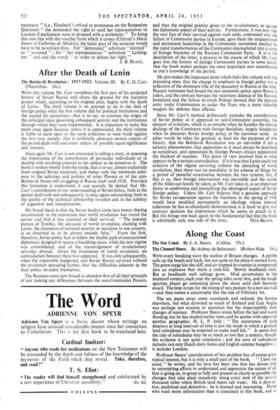Along the Coast
The Sea Coast. By J. A. Steers. (Collins. 25s.) The Channel Shore. By Aubrey de Selincourt. (Robert Hale. 18s.) Wrni every breaking wave the outline of Britain changes. A pebble rolls up the beach and back, but not quite to the place it started from. The green surge hits the cliff, and air trapped in crannies is compressed into an explosive that starts a rock-fall. Slowly headlands melt. But as headlands melt saltings grow. Mud accumulates in the sheltered corners; each year the spring tides cover less, and the tough spartina plants go colonising down the shore until slob becomes sward. The time is ripe for the inning of new pasture by a new sea-wall —and then comes a catastrophe like the tide of February 1st.
The sea pares away some coastlands and unloads the burden elsewhere, but what drowned so much of Zeeland and East Anglia was perhaps not erosion or accretion but the imperceptibly slow changes of isostasy. Professor Steers wrote before the last and worst flooding, but he has studied earlier ones, and he quotes with approval another geographer, H. L. P. Jolly : " The occurrence of such disasters at long intervals of time is just the mode in which a gradual land subsidence may be expected to make itself felt." It seems that the rate of subsidence may be as much as two feet a century, though the evidence is not quite conclusive ; and the area of subsidence includes not only Dutch dairy farms and English summer bungalows ; it includes London.
Professor Steers' consideration of this problem has of course great topical interest, but it is only a small part of the book. " I love the coast," he writes, and his love has been one that has driven him to unremitting efforts to understand and appreciate the nature of all that is going on, to grasp as fully and present as clearly as possible the changes that take place ceaselessly along every inch of the several thousand miles where British land meets salt water. He is descrip- tive, analytical and deductive ; he is learned and interesting. Those who want more information than is contained in this book, and in p ofcssor Steers' previous one on the coastline of England and Wales, s probably have to go and collect it for themselves ; there is, ofessor Steers tells us, ample scope for those who wish to do so. I here is so much not known. Though it possesses a sad little errata slip, the book is as well produced as others in the series, but it is a little melancholy to compare number one of the " New Naturalists," published in 1945 (48 colour plates. 16s.) with this volume which is number twenty-five (8 colour plates. 25s.). By so much'have costs advanced since the war.
Professor Steers gives us a synoptic account of all the British coast, island as well as mainland. Aubrey de Selincourt takes us down Channel from the Goodwins to Penzance, where he comes ashore for the last lap to Land's End. He is a literary yachtsman with a gift for vivid and accurate descriptive writing. He is best when he, gives a clear account of some scene that has caught and held his attention—the immense lehgth of Brighton front in the summer haze as seen from a yacht in the offing, the awe-inspiring seas of a full gale as seen from the same small yacht, the entrance to Fowey at dawn. Like so many other topographical writers, he is too apt to break the continuity of the book with historical snippets. It is not that the matters mentioned are uninteresting or irrelevant, but space is required for their expansion and elucidation ; if one lacks such space, it is perhaps best to let them alone Unless they have an obvious, visible connection with the affairs of today. One might wish indeed that the affairs of today were a little more prominent in the book. The naval actions referred to are not those recent ones which are freshest in our minds; the ships afloat on this author's Channel are mostly yachts, dead and gone fishing vessels and high-pooped merchantmen and pirates. But ereviewer must always beware of the temptation to scold a book for not, being what it was never meant to be. This is not a book about modern problems but a summer-holiday book by a well4ead, observant yachtsman who knows how to write. Perhaps, however, there is a permissible grumble about the photographs which illustrate the volume. All but one come from the files of that well-known firm Valentine's of Dundee. Most of them are neither old enough nor new enough to be of interest, and at least two—of the Needles and of Land's End—are downright bad, heavily re-touched by some ham-handed Dundonian. STEPHEN BONE.



































 Previous page
Previous page